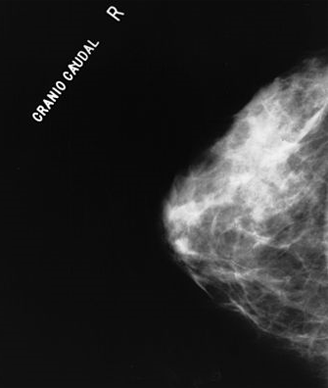Breast Imaging Technique May Reduce Repeat Biopsies
The combination of four imaging techniques together results in the ability to better differentiate between benign and malignant breast tumors, which may lead to fewer unnecessary breast biopsies.
Standard mammography (image) is being challenged by newer methods.

The combination of four imaging techniques together results in the ability to better differentiate between benign and malignant breast tumors, which may lead to fewer unnecessary breast biopsies. The study looked at the multiparameter approach to imaging, using up to four parameters in 76 women who had a previous suspicious or inconclusive imaging abnormality with either a mammogram or breast ultrasonography. The study was published in Clinical Cancer Research, a journal of the American Association for Cancer Research.
All of the women in the study underwent imaging with the combined technique, called multiparametric 18-fluorodeoxyglucose-positron emission tomography/magnetic resonance imaging (18-FDG-PET/MRI), and had histopathology evaluations of their breast tumor biopsies to determine the malignancy of the imaged mass.
The multiparameter PET/MRI imaging technique consists of a dynamic contrast-enhanced MRI (DCE-MRI), diffusion-weighted imaging (DWI), three-dimensional proton MR spectroscopic imaging (3D 1H MRSI), and 18-FDG-PET. The authors compared two- , three- , and four-parameter assessments, all of which included DCE-MRI.
Previously, two- and three-parameter PET/MRI imaging studies suggested that the more information on the breast mass, the “deeper the understanding of tumor biology, the more accurate tumor characterization, and the better the diagnosis,” said study author Katja Pinker, MD, of the Medical University of Vienna in Austria.
Pinker and colleagues sought to test whether the four-parameter approach could directly detect functional properties, such as glucose consumption, tumor neoangiogenesis, microstructural changes, and cell membrane turnover, all of which are involved in cancer growth, as well as if it could better distinguish cancerous tumors from benign masses. While DCE-MRI is able to detect breast tumors with high sensitivity, it is limited in its ability to find the functional properties of cancer cells.
In total, 53 malignant and 23 benign breast lesions, based on the histopathology analysis, were found. The multiparametric 18-FDG-PET/MRI was 96% accurate in differentiating between a malignant tumor and a benign tumor compared with the standard DCE-MRI method. The combined imaging technique may be able to reduce recommended unnecessary breast biopsies by about 50%.
For example, compared with three-parameter MRI (DCE, DWI, and 3D 1H MRSI), the four-parameter 18-FDG-PET/MRI “added slightly more information about the differentiation of benign and malignant breast lesions by correctly diagnosing a mass as malignant, which would have been deemed benign” using the three-parameter analysis because of a negative DWI and 3D 1H MRSI.
The tumors detected ranged from 5–77 mm, with a median tumor size of 24 mm. The women in the study were 25 to 86 years of age, with a mean age of 55.7.
According to the authors, multiparameter MRI provides a highly sensitive analysis, as well as both functional and morphological information and results in improved specificity compared with DCE-MRI alone.
Larger prospective studies that balance benign and malignant tumor assessments are still needed to confirm the increased specificity and increased accuracy of diagnosis when using the four-parameter imaging technique. Additionally, an evaluation to test whether the results are applicable to smaller tumors (less than 24 mm) is also needed.
Still, Pinker said that multiparametric PET/MRI of the breast is “feasible and ready to use, provided that a hospital is equipped with a PET-CT and MRI scanner or a combined PET/MRI. If the hardware is available, this technique can be immediately implemented in clinic.”
The combined PET/MRI imaging tool is still less cost-effective than currently used methods, but Pinker said that PET/MRI machines are being implemented worldwide. “In this study, there was already a significant reduction in unnecessary breast biopsies with PET/MRI, which will further improve the cost-effectiveness.”